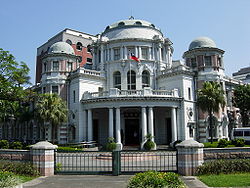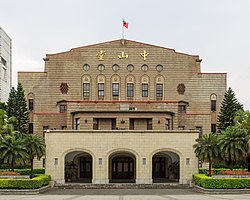Prehistory (−1621)
The architecture of prehistoric Taiwan saw structures ranging from cave dwellings, stilt housing, to stone masonry. Primarily of Austronesian architecture. [2]
- An observational painting of a stilt house of one of the plains indigenous peoples as depicted in Liu Shi Qi’s Taiwan Panorama Prints (六十七兩采風圖合卷).
- A stilt house of the Truku people
- Modern and traditional houses coexisting in present-day Tao settlement on Orchid Island
Cave dwelling
Prehistoric man made use of caves for their dwellings, and Taiwan's oldest known civilization is the Changbin culture (長濱文化) dating back to over 50,000 years. An example of an archaeological site of a cave dwelling is the Bashian Caves in Changbin Township, Taitung County which is dated from between 5,500 and 30,000 years. The actual cave itself has a height of around ten meters and can accommodate some ten persons.
Stilt housing
Spread over the vast prehistoric Pacific Ocean and Indian Ocean areas, stilt houses vary greatly. In more recent times, Taiwanese aborigines make use of them for holding church meetings, as places to cool down and to hold ancestral activities. Apart from their cooling effect, stilt houses also have various functions such as avoiding miasma, dampness, flood, and insects and snakes from entering, it is also easier to construct.
Stone-slab housing
The Paiwan and Bunun peoples made houses using thatched roofing and made walls from stones. Homes of nobles were decorated with elaborate wood carvings. The special characteristics of such houses is that dark colored building materials help conceal the buildings in its environment and the layered use of rocks mimic the scales of the hundred pacer snake that they worship. [3]
Aboriginal architecture
Chinese and aborigines made use of natural materials such as straw, wood, bamboo, grass, stone, and soil as basic construction materials. The types and styles of building vary depending on the environment, climate, and cultural influences of each ethnic group. For example, the Amis tend to live in larger communities and planned the layout of their community such as placement of communal homes and a plaza for matters of governance inside, planting a bamboo forest around the outside with camps and guard stations to defend against foreign aggressors. [4] The Atayal and Saisiyat peoples made their homes out of wood and bamboo, while the Tao people who lived further away on Orchid Island and faced strong changes in seasonal weather such as typhoons, developed houses that made use of digging vertically into the ground to strengthen their foundations. [5]
- Stone-slab house of the Paiwan people in Tjalja'avus Tribe (來義部落) taken by Japanese anthropologist Ushinosuke Mori prior to 1945
- Stone-slab houses in Pingtung Park
- Stone-slab housing of the Paiwan people in Tjuvecekadan Tribe (老七佳部落)
- An imitation slate house of the Paiwan people at the National Museum of Natural Science
- Traditional house of the Atayal people
- Inside an imitation of a traditional house of the Atayal people
- Houses of the Seediq people in Paran Tribe (巴蘭部落)
- Houses of the Bunun people
- View of a Tao tribe
- A house and its surroundings in a Tao tribe
- Inside a Tao house
- The Kakita'an ancestral house of the Amis people in Tafalong Tribe (太巴塱部落).
- Stilt-house of the Puyuma people
- An imitation kuba (men's house) of the Tsou people in Formosan Aboriginal Culture Village
- An imitation animal bone hut of the Tsou people in Formosan Aboriginal Culture Village
- An imitation granary of the Rukai people in Formosan Aboriginal Culture Village
- An imitation of a ceremonial rack of skulls of the Paiwan people in Formosan Aboriginal Culture Village
- A temple (公廨) of the plains indigenous peoples



















































































![Tai Nan [Yi Zai Jin Cheng ] Zheng Men .JPG](http://upload.wikimedia.org/wikipedia/commons/thumb/6/6f/%E5%8F%B0%E5%8D%97%E3%80%8C%E5%84%84%E8%BC%89%E9%87%91%E5%9F%8E%E3%80%8D%E6%AD%A3%E9%96%80.JPG/330px-%E5%8F%B0%E5%8D%97%E3%80%8C%E5%84%84%E8%BC%89%E9%87%91%E5%9F%8E%E3%80%8D%E6%AD%A3%E9%96%80.JPG)






































































































































